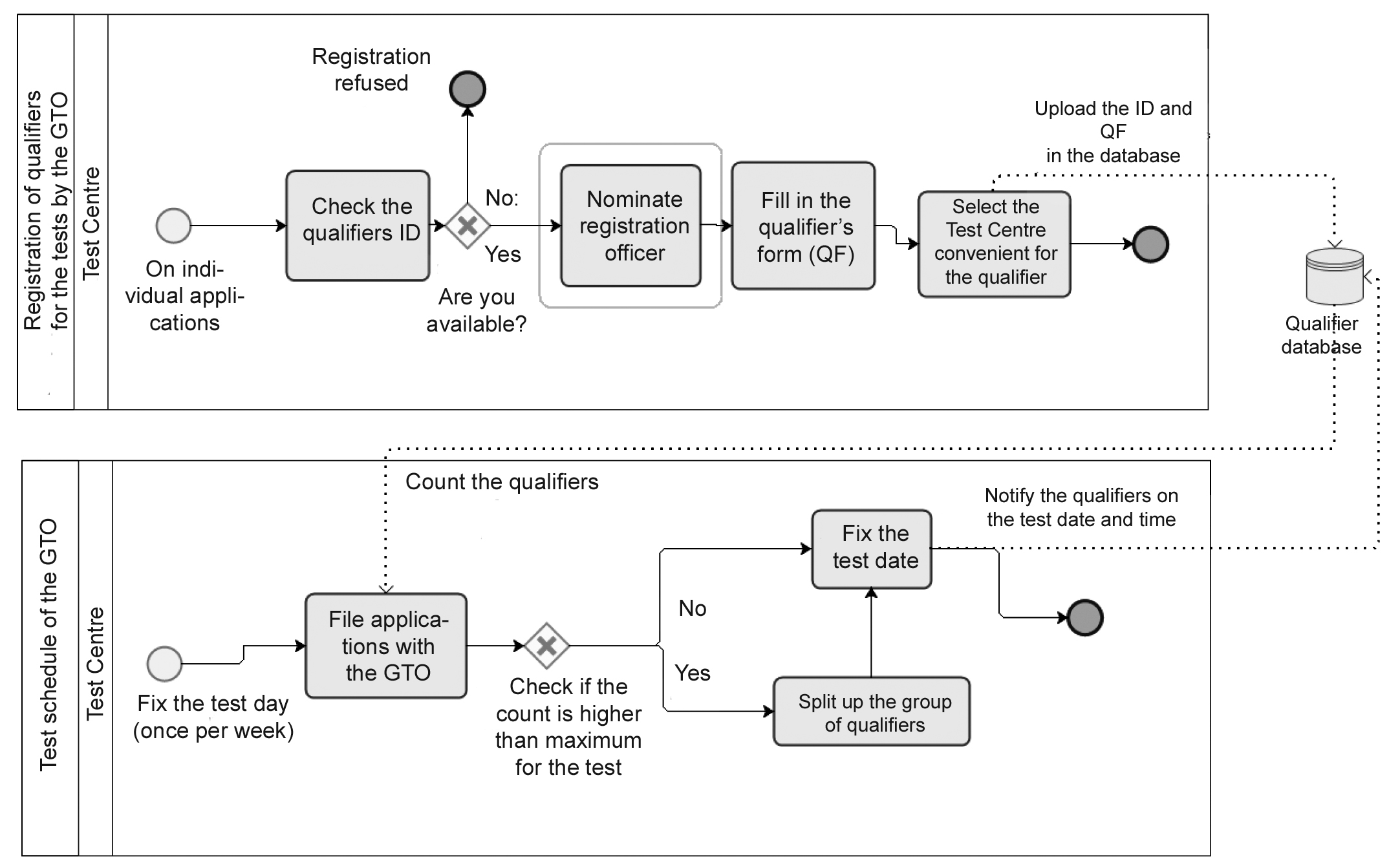Physical education and sport service process management model
Фотографии:
ˑ:
R.M. Olkhovsky1
PhD, Associate Professor I.V. Solntsev1
N.A. Osokin2
1Russian State University of Physical Education, Sport, Youth and Tourism (GTSOLIFK), Moscow
2Plekhanov Russian University of Economics, Moscow
Keywords: process management model, public services, physical education and sport service, Business Process Model and Notation (BPMN), business process management, administrative regulations.
Background. Process management model means herein the management concept considering corporate performance as a combination of certain elementary processes on the assumption that management can be efficient enough only if each process is duly designed and controlled. Process means the array of interrelated and duly structured actions geared to produce some good or service for the process clients with the process inputs being transformed in ready products/ outputs [1]. When a process management method is applied by a non-commercial or public institution for production of some social asset/ service, the relevant processes are often formalised in administrative regulations [4]. Furthermore, any management system may be basically described in the following two aspects: management object i.e. the one that is managed, and management subject i.e. the object manager. In terms of the process management model, the above notions are referred to as the process and process manager, respectively [6].
Objective of the study was to provide theoretical substantiations for the physical education and sport service process management model.
Study results and discussion
Benefits of the process management
It is the cross-functionality that may be referred to as the key characteristic of a business process that makes it different from regular operations of a business unit within a company. Business process may be also described as repeated, predictable and inclusive element with its clear end-to-end timeframe. Process management model is commonly accepted as the most beneficial for cross-functional actions. Table 1 hereunder shows the comparative analysis of the discretional, project and process management methods.
Table 1. Comparative analysis of the discretional, project and process management methods (compiled based on the prior study [3])
|
Aspect |
Discretional management |
Project management |
Process management |
|
Delegation of responsibility |
Via office memos |
On the project manager’s decision |
Automatic under the process chart |
|
Primary costs |
No costs |
Significant project start-up costs |
Significant process modelling costs |
|
Project costs |
High management costs |
High management costs |
Low management costs |
|
Result |
Result may not be guaranteed |
Expert control used to schedule the process |
Permanent monitoring and benchmarking analyses |
|
Performance control |
Based on the executives’ reports |
Actual performance may differ from the process schedule |
Process schedule and actions are harmonised |
Goals of the process modelling/ description process may be listed as follows:
- Transparency to clearly spell out the responsibilities of each process actor, detect upcoming problems and find solutions at every process stage.
- Planning to give a detailed understanding of the physical and human resource claimed by the process actions.
- Terms of reference to clearly specify the interdepartmental/ divisional cooperation and the relevant scopes of authority [2].
Benefits of the process management method also include the process model and clear hierarchical structure, with each process classified into elementary sub-processes, with such sub-processes proved to be the best solution in case of large-scale complex processes with multiple process actions [8].
Process model/ chart is considered one of the key process management elements designed using certain symbolic notations to specify each process element in its interrelations with the others. Presently IDEF notation system is the most popular for the process modelling purposes albeit its practical application for the process descriptions is somewhat limited in fact. Some modern notations are more efficient for the process automation purposes (EPC) and for the end-to-end management system designs, for example the BPMN (Business Process Model and Notation) system [7].
Physical education and sport service process management model
Processes (or administrative regulations in case of public and non-commercial organisations) give the means to level down interdepartmental disharmonies, secure strict compliance with the valid regulation and reduce the bureaucratic inefficiency in every process action. Schematics of the government-supported physical education and sport service management process may be used as the service standards to regulate both the service quality and requirements to the physical and human resource claimed by the elementary service sub-processes. The service process in the process management model is presented as an algorithm spelling out the operations on a step-by-step basis with specifications of the resource claimed by every elementary operation within the process.
Since practical results in any sport discipline are rather unpredictable [9], the process management model application in sports has its specifics in the sense that the required resource may be scheduled in detail but the competitive accomplishment may not be guaranteed. It is common knowledge that successes in competitions are not always proportionate to the resource claimed by the team or individual athlete’s training process. This is the reason for certain limitations to the process management model application in the physical education and sports industry. The model may demonstrate its full benefits mostly in the cases when the service providing entity directly interacts with the individual service client.
Furthermore, modern sports are special in this context as their results are multidimensional [10] i.e. rated by a variety of success criteria by the relevant sport institutions who seldom if ever apply only one specific success rate. Due to such system complexity, it is not always possible to trace causes and effects, i.e. incomes and outcomes for each process. Therefore, the end-to-end process management models that clearly describe the inputs/ resources and outputs/ results shall be prudently applied by the relevant sport organisations with full awareness of model limitations.
With the above logics in mind, we analysed the qualification and scheduling process model for the GTO Complex tests viewed as part of the test services provided by the Russian Physical Culture and Sports ‘Ready for Labour and Defence’ (GTO) Complex project: see Figure 1 hereunder. We applied BPMN 2.0 notation system for the process modelling, with the process model composed of the ‘pools’ to provide frames for the elementary processes with the ‘paths’ to the process executives and goals. The symbolic notations applied for the process modelling may be easily understood on an intuitive basis.

Figure 1. Qualification and scheduling process model for the GTO Complex tests
It is the existing economic development imbalances across the regions of the Russian Federation that may complicate the government-supported physical education and sport service process management model being implemented on a wide scale. The model may be applied to develop the service process charts with the lists of the resources claimed by the service elements on the Federal level; with the resource items being further detailed on the regional and municipal levels; followed by the process automation options being considered by the relevant local management bodies.In the above case we have two sub-processes correlated by the data exchange via the automated database of qualifiers for the GTO Test process. The qualification process produces a List of Qualifiers with their primary individual data fixed in the database followed by the GTO Test Centre decision on the test schedule.
Conclusion. The existing physical education and sport service system of the Russian Federation is in need of new management solutions and practices to improve the service quality and scope and guarantee the expected results. The service process management model may be considered one of such solutions that may secure the government-supported physical education and sport service process management model being more flexible and efficient in the resource management.
The government-supported physical education and sport service process management model may help make a decisive step towards the whole service system being automated to notably improve efficiency of the service providers and the service scope and quality.
References
- Belaychuk A. Glavnoe preimuschestvo BPMN [The core advantage of BPMN]. Otkrytye sistemy. SUBD, 2012, no. 8, pp. 61-62.
- Ignatyuk N.A. Administrativnye reglamenty federalnykh organov ispolnitelnoy vlasti: voprosy metodologii [Administrative regulations of federal executive bodies: methodological issues]. Rossiyskoe pravo, 2006, (10 (118)).
- Kozlov A. Proektirovanie iissledovanie biznes-protsessov. Ucheb. posobie [Design and research of business processes. Study guide]. Litres publ., 2015.
- Repin V., Eliferov V. Protsessny podkhod k upravleniyu. Modelirovanie biznes-protsessov [Process approach to management. Modeling of business processes]. Litres publ., 2017.
- Samuylov K.E., Serebrennikova N.V., Chukari A.V. et al. Osnovy formalnykh metodov opisaniya biznes-protsessov [Fundamentals of formal methods to describe business processes]. Moscow: RPFU publ., 2008, 130 p.
- Skripko L.E. (2011). Protsessny podkhod v upravleniikachestvom.Ucheb. Posobie [Process approach in quality management. Study guide]. St. Petersburg: St. Petersburg SUEF publ., 2011.
- Solntsev I.V., Osokin N.A. Ispolzovanie severoamerikanskogo podkhoda v upravlenii sportivnymi ligami v Rossii: opyt kontinentalnoy khokkeynoy ligi [North American approach in management of sports leagues in Russia: continental hockey league experience]. Vestnik Tomskogo gosudarstvennogo universiteta, 2016, no. 412.
- Solntsev I.V. Postroenie sistemy upravleniya regionalnymi sportivnymi federatsiyami na baze reytingov (na primere futbola) [Design of rating-based management system for regional sports federations (case study of football)]. Regionalnaya ekonomika: teoriya I praktika, 2016, no.5 (428).
- Hammer M., Champy J., & Le Seach M. (1993). Le reengineering. Vol. 93. Paris: Dunod.
- Parmenter D. Key performance indicators: developing, implementing, and using winning KPIs. John Wiley & Sons, 2015.
- Reijers H.A. (2003). Design and control of workflow processes: business process management for the service industry. Springer-Verlag.
- Smith H., Fingar P. Business process management: the third wave, Tampa: Meghan-Kiffer Press, 2003, vol. 1.
Corresponding author: ilia.solntsev@gmail.com
Abstract
The study considers promises and potential benefits of the physical education and sport service process management model with a special emphasis on its advantages versus other popular management models (project, discretional etc.); and identifies the key specific features of the model that make it particularly beneficial for the public service sector. The key benefits of the model may be listed as follows: it bridges the gaps in the interdepartmental management system; secures the valid standards and requirements being strictly observed; and scales down the bureaucratic inefficiency in the process. It should also be mentioned that a process may have two meanings: as the physical culture and sport service standard and the service pricing standard, provided a clear process hierarchy is established with each operation spelled out and supported with the necessary resource. Each process model shall be available – as demonstrated by the qualification and test scheduling process management model for the Russian Physical Culture and Sports ‘Ready for Labour and Defence’ (GTO) Complex. The authors also offer the key arguments for the physical education and sport service process management model to be widely accepted and implemented, and the main reservations and barriers for such projects.



